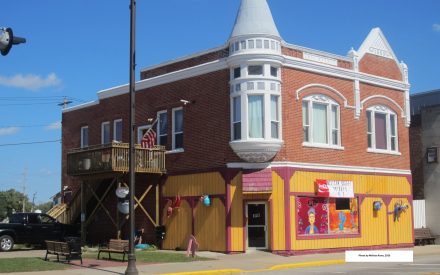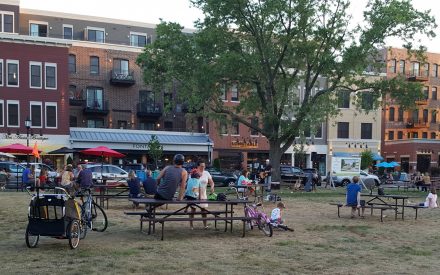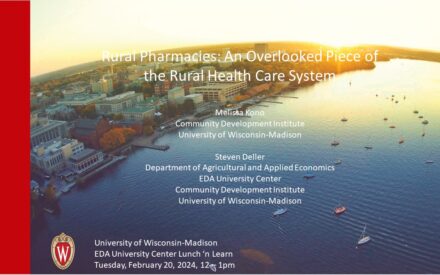April 2018 — Downtowns traditionally provide shopping, entertainment, social, and employment opportunities, as well as property tax revenue, for their respective municipalities. For residents, visitors, and local governments, downtowns can also serve as an indicator of the economic health of the entire community.
As technology advances and the population ages, the roles of many downtowns are changing. As a result, their landscapes are evolving. Previous, often long term, retail tenants are leaving, allowing municipalities two options:
1. Allow the now-vacant buildings and storefronts, and, the overall downtown, to remain vacant and decay.
2. Identify new markets and possibilities while promoting local attractions and creating new assets and opportunities that appeal to growing market segments including tourists.
The second option, of course, is more likely to lead to economic growth in downtowns and improve the community’s quality of life.
Changing Conditions and Roles of Downtowns and Obstacles to Development
Downtowns are used as barometers for a community’s economic health because people tend to spend their incomes on local businesses. However, as residents continually commute further for work, often to larger regional centers, the downtowns in their own communities face heightened competition. Some Illinois communities are also seeing businesses relocate from downtowns to shopping centers to take advantage of agglomeration economies, more merchandising space, and better parking.
Downtowns in Illinois vary widely in their current conditions; some mayors report growth and investment while others report a decline. For example, 43% of mayors say that the streetscape and public space have been improved, while nearly 25% say that “retail functions in the downtown are nearly gone.”
Obstacles to development reported by Illinois mayors include:
- Residents shopping over the internet
- Slow population growth or population decline
- Closings of important stores
- Declines in employment with residents relocating to other areas
- Expansion of retail and discount centers in other regions
- Retiring business owners with no heirs interested in continuing the business
Downtowns must also be able to adapt to changing demographics, shifts in purchasing patterns (including sector preferences), and changes in marketing strategies that are occurring with technological advances.
Logistics and Financing
Before discussing the specific strategies used by local governments to improve their downtowns, it is important to summarize the logistics and finances behind their implementation.
Chambers of commerce, municipal staff dedicated to downtown activities, local nonprofit organizations dedicated to downtown, and private consultants were all named by mayors as having at least some responsibility for managing downtown strategies. Municipal staff were most likely to hold responsibility for managing downtown strategies, though this varied with municipality size.
Implementation Strategies
Tax Increment Finance (TIF) was used in nearly 70% of responding municipalities. Other financing methods and their frequency of use are:
- Reliance on general property taxes (57%)
- Sales tax revenues (48%)
- State grants (32%)
- Funds raised by local agencies, such as downtown nonprofits or chambers of commerce (29%)
- Hotel/Motel tax receipts (33%)
Many Illinois mayors plan to implement these strategies over the next five years. They reported unique approaches to recognize and build on their local assets.
- Initiate improvements that increase the downtown’s attractiveness and functionality, such as streetscaping or façade grants. Ottawa, Illinois had success with a TIF-funded beautification program.
- Increase the number of visitors by branding, marketing, and providing new attractions. This can include enhancing their existing recreational opportunities, especially outdoor recreation, and connecting the downtown, either physically or through association, with recreation that may be outside of its boundaries but still within the community.
- Enhance residential and/or entertainment activities, especially as younger generations seek a downtown living. Some examples of these activities include crafts, theatres, galleries, studio space, and music venues. Making downtowns more resident-friendly can also help property owners adapt former retail space to office or service space and improve and/or expand public services such as libraries and community centers.
- Improve and update infrastructure, which has two outcomes: increasing traffic, thereby expanding markets for both current and future businesses, and enhancing the downtown’s role as a social center.
- Expand transportation facilities, such as the Quad Cities Multi-Modal Station passenger rail facility in Moline, IL, which led directly to further development downtown.
- Upgrading internet access and other communications facilities is also an infrastructure upgrade, but notable enough to be featured on its own. This allows for future technology advances and businesses that would arise from them. It also allows for services such as health and education to locate downtown.
- Explore potential new uses, orientations, and even purposes of the downtown by increasing local activities, such as co-working and live-work spaces, placing less emphasis on traditional retail.
- Capitalize on the community’s unique aspects such as cultural assets, festivals and events, unique food and beverage (such as breweries), universities, natural resources, redevelopment opportunities, and historic preservation.
Mayors were particularly interested in possibilities for a statewide thrust to make downtowns more effective in local economic development. They also identified the types of technical assistance they would like, such as to:
- Create a plan to recruit downtown businesses
- Brand and market the downtown
- Access online economic development tools
- Create a plan-vision from community input
- Complete market analysis
- Conduct surveys of business performance/conditions
- Receive training on best local development practices
To deliver such assistance, Northern Illinois University Center for Governmental Studies-Growing Communities Initiative is expanding the set of services offered to include additional affordable and easily accessible technical assistance in areas such as market research, strategic planning, and implementation strategies, as well as expanded online resources.















 Rural Pharmacies an Overlooked Piece of the Rural Health Care System
Rural Pharmacies an Overlooked Piece of the Rural Health Care System The Economics of Downtown Revitalization: Putting Some “Oomph” Behind the Numbers
The Economics of Downtown Revitalization: Putting Some “Oomph” Behind the Numbers The Hotel Industry: Recovery and Future Development in Our Communities
The Hotel Industry: Recovery and Future Development in Our Communities Focus Group Analysis Tips
Focus Group Analysis Tips


